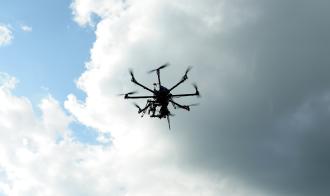Cue the scene: humans of the not-so-distant future, racing through a field of skulls, trying to keep one step ahead of our own creations… then a buzz fills the air! A fleet of robots from Skynet (apparently only a decade away, which seems right on schedule) crests the horizon. And all this because, in 2019, a team at the University of Michigan attached a nail gun to a drone…
Sorry to disappoint the ready and willing robot resistance, but Michigan’s industrial-grade, nail gun-wielding octocopter will most likely not be the first step towards our new robot overlords — at least not without saving a few lives first.
According to OSHA, one in five workplace deaths in 2017 were in construction. Of those, more than half were caused by what they snappily dub the “fatal four”. The most common of this morbid category: falls.
Per Gizmodo, the drone is currently capable of zipping up to a roof and nailing shingles down with precision. Using cameras and location markers, the drone can ably (and safely) perform a task that is remarkably dangerous.
According to OSHA, one in five workplace deaths in 2017 were in construction. Of those, more than half were caused by what they snappily (if morbidly) dub the “fatal four”: from least to most common, they are being caught in or “compressed by” equipment, objects, or structures; electrocutions; blunt force trauma from objects on the job; and, at number one, falls.
If these four causes were curtailed, OSHA says over 500 lives would have been saved that year. Considering that a lack of fall protection on construction sites was the most cited safety violation in 2018, safer options are needed urgently.
Using drones to replace high-elevation jobs like bridge, line, and windmill work is obvious, but they could actually save more lives by replacing dangerous mundane tasks like roofing. Gizmodo’s Andrew Liszewski envisions a swarm of them topping off construction of a new house, or imagine setting a buzzing cloud free on a hurricane-ravaged island, working tirelessly to repair the storm damage that will increase in frequency and severity as climate change continues to take course.
The Cold Water
Those drones would have to move quite a bit faster than Michigan’s does now, unfortunately. While the nail-drone is accurate, it’s downright pokey compared to a person. Further limiting its potential is the bane of all technological achievements: battery life. Powered by eight rotors and weighed down with a heavy industrial nail gun, the prototype currently can only fly for 10 minutes.
Gizmodo’s Andrew Liszewski envisions a swarm of them topping off construction of a new house, or imagine setting a buzzing cloud free on a hurricane-ravaged island, working tirelessly to repair the storm damage that will increase in frequency and severity as climate change continues to take course.
Construction drones will also have to risk the wrath of the FAA. In the wake of drones foolishly equipped with devices such as flamethrowers, the agency that rules the skies put out a statement making clear how they feel about it: don’t do it. Making job sites safer is a nobler goal than because-it’s-cool weaponizing, of course, but the potential for abuse cannot be ignored, if we want the Sarah Connors of the world to welcome our benevolent, nail gun-bearing overlords.
